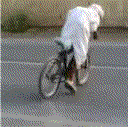The Traction Circle
The Basics
They talked about this in MSF. The more the weight is on one end of the bike, the more traction it has. There's only so much traction to go around -- you can use it for acceleration, braking, turning, or a combination of those. What is amazing is that many track riders -- and almost all street riders -- only use half the circle.
Today I want you to maintain a traction reserve -- leave a border around that circle so you can concentrate on technique rather than managing slides. So when I talk about the traction circle here, I'm really talking about one that's actually inside it, leaving a safety margin:
 Using the traction circle
Using the traction circleIn the classic corner, you brake, then turn, and roll on the throttle as you come out of the turn -- slow, look, lean, roll. When you plot this on the traction circle, you'll see that uses only the bottom half of the circle:
 Trail braking
Trail brakingWe're going to use the whole circle. By trailing off the brakes as we turn in -- trail braking -- we fill in the top half of the circle. That means we can save some of our braking for when we're in the corner, and so can brake later. (We also get other benefits we'll talk about later.)
Trail Braking is an often misused term by those who don't understand it. Note that it has nothing to do with what brake you're using. It just means that you keep braking as you go into the corner, trailing off the brake as you go deeper into the corner.
 Using the weight transfer
Using the weight transferRemember that traction on a given end of the bike depends on the weight on that end. By trail braking, we put weight on the front when it needs it most, when it's turning into the corner. Then as we ease off the brake we distribute it more evenly between front and rear. As we accelerate out of the corner we put the weight on the rear -- at that point the rear of the bike is doing almost everything, and the front is just along for the ride.
This is managing weight transfer. It's using the weight transfer to help out the tires and get the most out of the bike.
From TrackDoD Novice Group Orientation



No comments:
Post a Comment